This chapter is structured around the three pillars of the OECD Framework for Digital Government Talent and Skills necessary to conduct digital transformation, which requires a digital enabling work environment, five digital government skills and a sustainable digital workforce. The first section presents the Framework for Digital Government Talent and Skills. The second section assesses and applies the framework to the Slovenian context while giving suggestions for improvement.
Digital Government Review of Slovenia

3. Digital talent for a transformative public sector culture
Abstract
Introduction
Given the disruptive aspect of digital technologies in society, governments’ role in meeting citizens’ expectations, managing increasing pressures on budgets and responding to new policy issues have become challenging as digital disruption means constant change and rethinking ways of operating to deliver public value in the public sector. However, this paves the way for evolution and growth and, if well-done, it would maintain and restore trust from citizens. The COVID-19 pandemic presented a new challenge to the delivery of public services (see Chapter 4), but it also has demonstrated the importance of a more flexible and adaptable public sector when facing uncertain circumstances. In analysing the impact of the COVID-19 crisis as a catalyst for government transformation, the OECD has found that governments scoring high in the OECD Digital Government Index were better prepared to use digital technologies and data and demonstrated greater resilience and responsiveness as a result. In other words, developing digital government maturity to act as “digitally enabled states” is key to managing crises (OECD, forthcoming[55]; OECD, 2020[56]) (See Chapter 1).
In line with the 2014 OECD Recommendation of the Council on Digital Government Strategies (OECD, 2014[57]), a successful digital transformation requires several key aspects. Governments need to be equipped not only with the right technology but also with the right working environment, the right skills and the right talents to support the progression from e-government to digital government (OECD, 2021[58]). Indeed, since a country’s digital maturity is determined by how well the country is able to integrate digital technology into all sectors and services, changing how they operate to deliver public value to citizens, this also includes a cultural shift that requires organisations to continually challenge the status quo, experiment and get comfortable with failure.
Slovenia has the aspiration of moving from e-government to digital government and is placing their digital policies high on its agenda. To accompany this ambition, a digital workforce is necessary to lead and enable sustainable change. Governments must rely not only on the digital capability but also on the complicity of their public servants to take initiative and transform digitally which, in the long run, will nurture relationships with citizens and deliver better public services.
For digital transformation to happen, governments’ focus on creating a work environment that is suitable to the development and application of digital government skills is fundamental. Although numerous analyses have identified the skills needed for 21st century governments, none has exposed the skills for a digital government and the importance of digital skills. Consequently, the OECD developed the Framework for Digital Government Talent and Skills which is meant to fill this gaps and identifies three major pillars to consider while building and maintaining a digital public workforce (OECD, 2021[58]).
This chapter starts by presenting the Framework for Digital Government Talent and Skills in the Public Sector, which emphasises the importance of the work environment, of developing the right skills to conduct a digital transformation and of attracting talents that will stay. The analysis then focuses on the current situation in Slovenia, addressing the policy efforts implemented or considered by the country’s digital strategy and covering actions the country could further consider in terms of talent and skills to improve its evolution towards a digital government.
The OECD Framework for Digital Government Talent and Skills in the Public Sector
Digital technologies have created the need for more diverse and deeper knowledge and skills. Given this rapid advancement of digital technologies, a whole world of research and studies have shed light on the necessary skills at different levels: societal, organisational, and individual and team levels (OECD, 2017[59]; OECD, 2017[60]; OECD, 2019[61]). Breaking down the analysis and identification of skills is crucial, given the scopes and layers of complexity that each level brings to the table to better understand needs and meet expectations. While societal skills focus on the ability to use digital tools in our daily life and organisational skills relate to a narrower set of sectorial needs (Figure 3.1), the individual and team skills of the public sector rely on the OECD Framework for Digital Government Talent and Skills (Figure 3.2). This framework has been conceived to guide the public sector in achieving digital maturity, as equipping public servants with current and emerging skills in a steady and disciplined manner should be the strategy for organisations to survive in the age of disruption.
Figure 3.1. From societal, to organisational, to individual and team skills

Source: OECD (2021[58]), “The OECD Framework for Digital Talent and Skills in the Public Sector”, https://doi.org/10.1787/4e7c3f58-en.
Building on previous work on societal and organisational skills, the OECD Framework for Digital Government Talent and Skills presents three pillars. First, pillar 1 examines the importance of the context for those working on digital government and assesses the environment required to encourage digital talent, referring to individuals and teams working in digital, to lead digital transformation. This part of the framework not only highlights how governments should appraise their leadership, organisational structures, learning culture and ways of working but also shows how conducive the workplace environment is for a digital workforce from a leadership, organisational and cultural point of view (OECD, 2021[58]).
Secondly, and at its heart, the next pillar unpacks the definition of skills for a digital government. This part locates the skills for a digital government in the broader context of 21st century skills before looking at four additional areas of skills required for a digital government: user skills, socio-emotional skills, professional skills and leadership skills. It identifies the areas in an organisation’s model of skills and competency that need developing to support greater maturity of digital government (OECD, 2021[58]).
Finally, the third pillar considers the practical steps and enabling activities required to establish and maintain a workforce that encompasses the skills for a digital government. Recruitment methods, career planning, workplace mentoring, training and the role of the public sector need to be redesigned. This creates opportunities to improve approaches to particular areas and ensure that the workforce is, and remains, sufficiently digital (OECD, 2021[58]).
The core of the framework is the focus on the digital skills required by public servants, which are powered by the capacity for teams and individuals to thrive in their work. The training, development and application of digital skills are thus determined by the relationship between the work environment and the ongoing efforts to establish and maintain a digital workforce (OECD, 2021[58]).
Figure 3.2. The OECD Framework for Digital Talent and Skills in the Public Sector

Source: OECD (2021[58]), “The OECD Framework for Digital Talent and Skills in the Public Sector”, https://doi.org/10.1787/4e7c3f58-en.
Digital skills and cultural landscape in Slovenia
As indicated by the OECD Digital Government Index (OECD, 2020[62]), successful digital governments are better equipped to make the most from digital technologies and data as they set up an environment to unleash them, ensure to have the right skills to exploit them and the right system to maintain the outcome to continue growing in digital maturity. Applying the three pillars of the OECD Framework for Digital Government Talent and Skills will guide governments into setting favourable conditions to welcome digital change.
Scoring slightly above the OECD average (OECD, 2020[62]), Slovenia could benefit from a particular attention to having talents equipped with digital skills to lead the transformation while building a sustainable workforce. This section assesses the findings collected, from interviews in October 2019 through a Digital Government Survey of Slovenia circulated in early 2020 and from a capacity building workshop on digital talent and skills in December 2020, against the three pillars of the framework and share suggestions and advice to boost digital transformation in the country.
A digital enabling environment
In line with the OECD Recommendation on Public Service Leadership and Capability (OECD, 2019[63]) and with the OECD Recommendation of the Council on Digital Government Strategies (OECD, 2014[32]), a country’s leadership is fundamental to conducting the shift from e-government to digital government. The experience of several OECD member and non-member countries demonstrates that a solid direction and a clear vision from leaders would not only enlighten the purpose of an organisation but also promote the benefits of digital government and establish a work culture focused on digital practices (see Chapter 1 and 2) (Kulkarni and Scott, 2019[64]).
In Slovenia, considerable political changes happened in the past decade which have possibly affected the set-up of a digital culture to steer and co‑ordinate across the government structure (Chapter 1 and 2). During the OECD mission to Slovenia, the team noticed some important efforts being made to centralise information at GOV.SI and services under eUprava (discussed further in Chapter 4). This proves that a strong leadership with a clear and forward-looking vision could help to establish goals and behaviours that strengthen collaboration across sectors within the workplace.
However, leading with purpose and aspiration is one thing; communicating it is another. Results from the Digital Government Survey of Slovenia (OECD, 2020[5]) show that 76% of public servants perceive digital skills and competencies as a medium to low priority in the digital government agenda of Slovenia (Figure 3.3). A large majority of public servants considered that digital skills are encouraged to have but are not required and that only staff working in specific areas should be trained. Therefore, it seems that the digitalisation strategy was not well-communicated throughout organisations. Governments failing to disseminate their strategy across public institutions may face challenges, as their workforce is likely to misunderstand the common objective and thus focus on other activities. For this reason, the initiative to improve the digital skills and competencies of public servants becomes a personal initiative for many public servants rather than part of a digital agenda.
Figure 3.3. Digital skills and competencies priorities in the digital government agenda of Slovenia
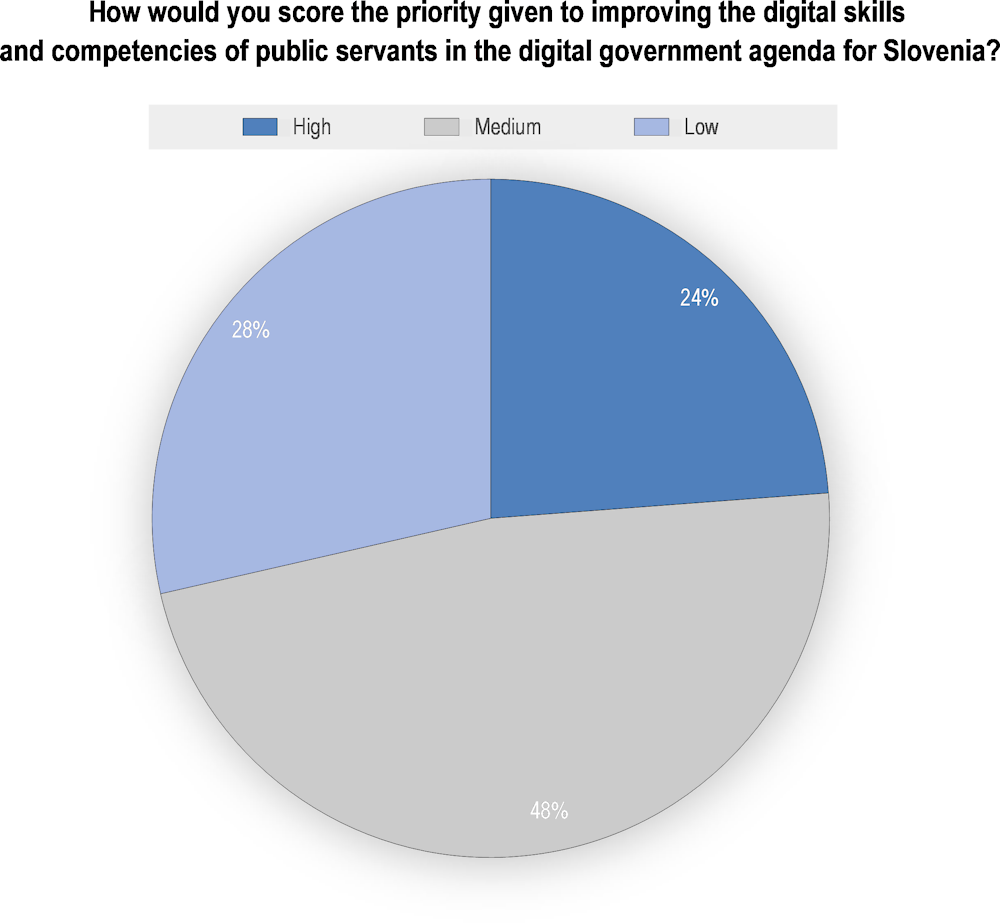
Note: Based on the responses of 45 institutions.
Source: OECD (2020[5]), Digital Government Survey of Slovenia, Public Sector Organisations Version. Question 17 “How would you score the priority given to improving the digital skills and competencies of public servants in the digital government agenda for Slovenia?”
Aligned with the previous finding, the survey identified that 77% of participants lacked motivation to improve digital skills and competencies (Figure 3.4), as few showed interest in joining and applying for training and courses. This might result from the lack of communication of the strategy’s priorities and a misalignment of the values of digital skills and competencies in the eyes of public servants, which explains their low motivation towards digital training. Consequently, this has led to more demand for external provision of services, which not only creates a lack of internal skills but also results in teams being overloaded by more administrative and managerial tasks than technical ones. In the long term, this practice puts at risk the capacity to control and understand what is being developed and to co‑operate with other teams, as the lack of internal skills restricts the flexibility to operate in an agile way.
To stimulate digital transformation, Slovenia could consider conveying the advantages of digital transformation and including digital talents in the decision-making process by empowering them with digital skills and competencies. Ensuring the workforce shares and understands the goal of the country is the cornerstone of digital change.
Figure 3.4. Level of motivation of improving digital skills and competencies in the Slovenian public sector
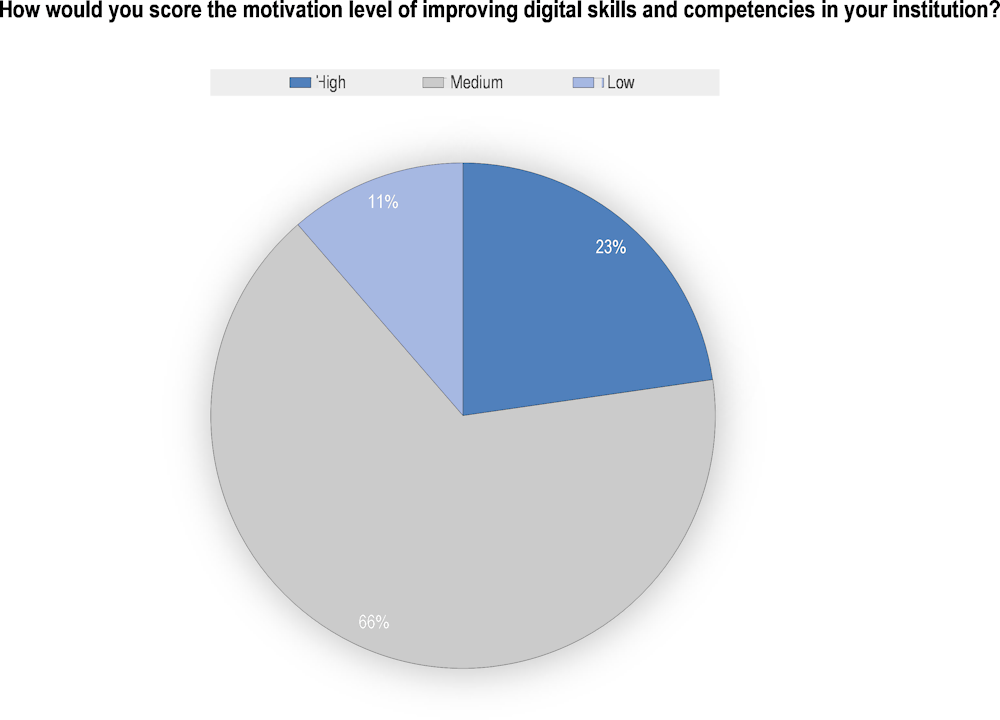
Note: Based on the responses of 45 institutions.
Source: OECD (2020[5]), Digital Government Survey of Slovenia, Public Sector Organisations Version. Question 18 “How would you score the motivation level of improving digital skills and competencies in your institution?”
Although the project of centralisation through GOV.SI (see Chapter 4) is a great opportunity for collaborating and deepening synergies between institutions, a lack of engagement has often been observed. This has resulted in some people’s perception of such an initiative as being a top-down decision instead of an invitation to a joint one. During the capacity building workshop, the OECD team confirmed that there seems to be some rigidity in the organisational structure and that most decisions are being made in silos by leaders. This observation reveals that the organisation has a hierarchical structure, which makes the system more bureaucratic and leads to less collaboration and longer decision-making processes. Establishing an organisational structure that flattens the interactions between individuals of an entity and scopes out future needs in the public sector is critical to encourage collaboration between digital talents and increase the feeling of ownership of their work. Another benefit of having fewer layers in an organisation’s structure is the possibility to quickly identify and adjust job profiles and descriptions (OECD, 2021[58]) according to needs.
To foster digital transformation, the Government of Slovenia may need to consider establishing a more horizontal structure to offer a more agile environment where digital talents feel empowered in their work. As shown in the example in Box 3.1, Australia anticipated transformations in the next decade and called for a reduction of organisational layers to allow faster and better decision making by bringing the right experts around the table. Given that digital government evolves in a fast-changing environment, institutions need to adapt and be flexible to improve decisions and meet the changing needs and expectations of citizens and businesses.
Box 3.1. The Australian Public Service Review
In May 2018, the Australian government commissioned a review to ensure the Australian Public Service (APS) was fit for purpose. The process engaged with more than 11 000 individuals and organisations and over 400 consultations to conclude that service-wide transformation was needed to achieve better outcomes. This was not to say that the APS was broken but that the status quo was insufficient to prepare for the changes and challenges anticipated in the next decade.
Recommendation 32 of the review was to streamline management and adopt best-practice ways of working to reduce hierarchy, improve decision-making, and bring the right APS expertise and resources. The implementation guidance called for management structures to have no more organisational layers than necessary in order to allow for decision-making at the lowest practical level with spans of control reflecting the type of work being managed, structures providing flexibility to respond to changes and jobs classified according to work level.
Source: Commonwealth Government of Australia (2019[65]), Our Public Service, Our Future. Independent Review of the Australian Public Service, https://pmc.gov.au/sites/default/files/publications/independent-review-aps.pdf.
Given the progressive use of digital technology across government institutions, there is also a need to consider embracing a more receptive workplace to digital settings and lifelong learning. This comes with an environment set by leaders fostering digital experimentation, the application of new digital skills and the creation of a solid learning culture. Although the Administration Academy provides training to fill in digital skills gaps (further discussed in the next section), a large number of participants shared that some leaders did not understand the need for constant training and have insufficient resources to encourage digital skills. The lack of prioritisation and funding of digital skills is a challenge to digital transformation, as it could convey the message that digital skills are not a priority. Funding continuous training is a direct way of showing leaders’ support for lifelong learning and their contribution to talents’ career growth and development.
Once talents are trained with the necessary skills, they need an environment that supports and encourages them to put their skills into practice. Establishing a learning culture is an important element to enable digital transformation and foster innovation, as it creates a safe place for staff to test ideas, use digital tools and experiment with digital skills. Findings from the mission to Slovenia displayed concerns about the lack of opportunities to pilot and experiment, as well as the fear of failure. In addition to this, the survey found that more than half of public servants were not encouraged to apply digital skills they learned (Figure 3.5). Although almost 40% of participants expressed that they were encouraged to test, use and experiment in small groups and through internal workshops, these issues may create anxiety for staff unable to use technologies and increase the dependency on third-party external actors. In this situation, leaders play a vital role in establishing not only a change of mindset by putting the human in the centre of the strategy but also a safe environment for talents to expand their digital skills, experiment with confidence and embrace failure.
Figure 3.5. Existence of testing, using and experimenting practices in Slovenian public institutions
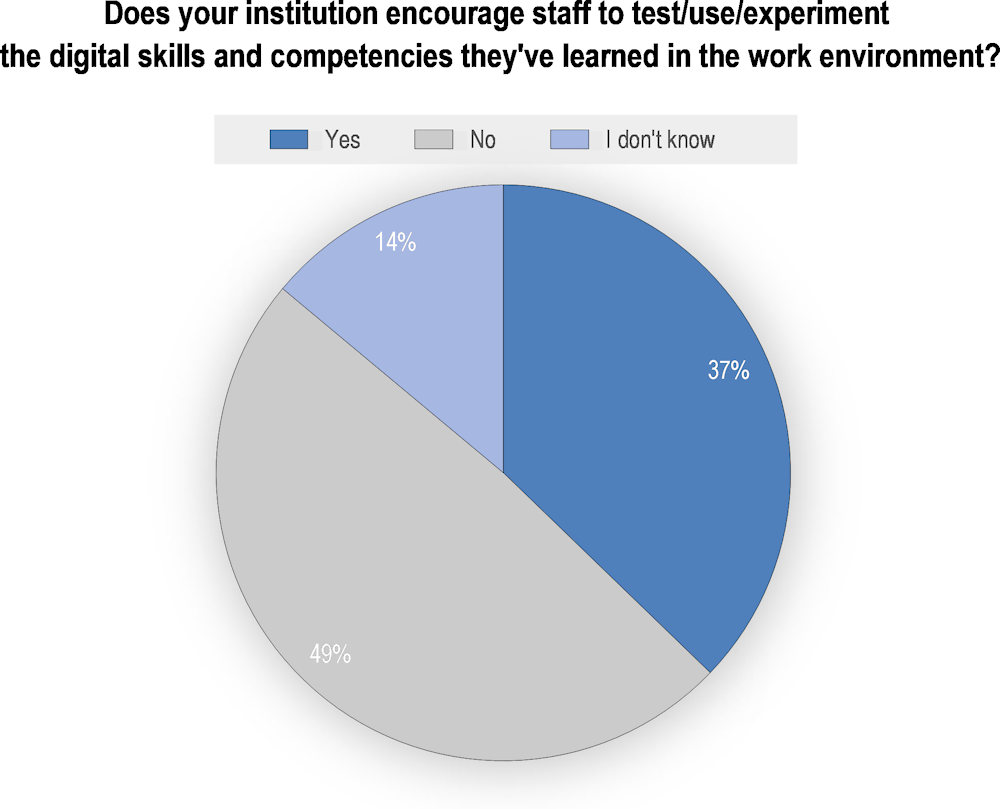
Note: Based on the responses of 45 institutions.
Source: OECD (2020[5]), Digital Government Survey of Slovenia, Public Sector Organisations Version. Question 22 “Does your institution encourage staff to test/use/experiment the digital skills and competencies they’ve learned in the work environment?”
The 2019 OECD Recommendation on Public Service Leadership and Capability (OECD, 2019[63]) champions governments’ creation of a learning culture and environment in the public service that goes beyond traditional classroom training. Data collected by the OECD Survey on Strategic Human Resource Management (OECD, 2019[66]) show a large recognition of the value of learning and development among governments in OECD countries, which are also essential preconditions to foster public sector innovation (OECD OPSI, 2020[67]). As seen in Figure 3.6, about 70% of countries (25 out of 36) have organisational learning plans in place in each organisation within the central public administration (OECD, 2019[66]). This more strategic role of leaders could enable the development and growth of a more digital workforce to adapt to an increasingly digital society.
Figure 3.6. Learning and development initiatives and training priorities in public administrations, 2019
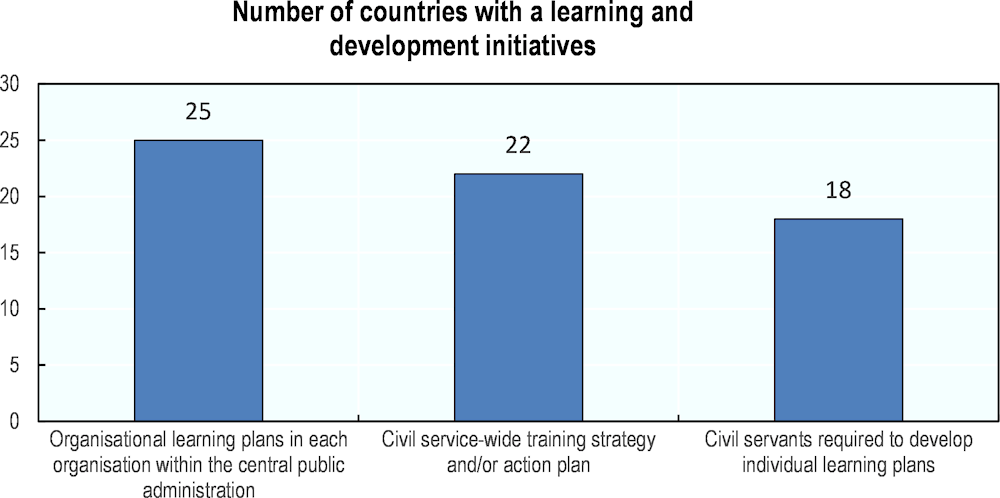
Note: The figure shows data for the total respondents of 36 OECD countries.
Source: OECD (2019[66]), OECD Survey on Strategic Human Resource Management.
The rapidly changing environment of digital government has pushed organisations to adopt new ways of working and to keep up with the pace of digital technologies. Flexible ways of working have surfaced in recent years, embracing measures such as using adequate tools and technologies at work, having flexible working hours and flexible workplaces, along with applying user-centred methodologies. The COVID-19 pandemic has not only forced many governments and organisations to change their ways of working rapidly but also demonstrated the benefits of digital government and accelerated its transformation in many of them.
The OECD Digital Economy Outlook 2020 found that 34 out of 37 OECD countries had put in place a national digital strategy co‑ordinated at the highest level of government as of mid-2020 (OECD, 2020[68]). Although the strategic trends of digital transformation are encouraging and governments are evolving towards a digital government, there is an urgent need to have access to the appropriate tool and skills. Access to equipment, resources and software are essential to establish a digital enabling work environment that promotes digital transformation. These elements would allow talents to access what they need when they need it, which is an important aspect of productivity, particularly in terms of having the autonomy to make decisions about what best supports their working practices (Kratzer, Leenders and Van Engelen, 2006[69]).
In Slovenia, the institutions were challenged to adopt teleworking policies overnight due to COVID-19: at the beginning of the crisis, 10% of public servants began working at the office and 50% at home, with 40% on leave or placed on a 20% salary cut. Slovenian public servants who experienced working from home benefitted from a better work-life balance and an increase in well-being, showed higher productivity and lowered costs for the institutions. Over the pandemic, the Administration Academy has adapted most training programmes into online courses, provided virtual training for the EU Presidency of Slovenia, as well as for the use digital tools. However, they also recognised areas that need adjustment to better incorporate this new way of working. Communication tools are one of them. Since organisations use different platforms to work and communicate between colleagues, collaboration could be more challenging to prevent teams from working in silos.
As working from home was not a common practice, the country was neither able to equip all its staff for teleworking nor give them access to tools and resources without endangering the level of cybersecurity. Although they managed to offer some distance learning facilities through the Administration Academy, this experience validates the necessity of having adequate tools to work remotely and flexible working policies in place to sustain an agile culture. Slovenia could consider investing in suitable tools to enhance productivity. Formalising these working methods is also an opportunity to ensure their application. However, it is critical that they be approached in ways that help staff to establish new behaviours and that emphasise people’s feelings of agency and empowerment instead of giving any sense of enforced compliance (OECD, 2021[58]).
To build a suitable work environment for digital transformation, the Government of Slovenia could not only adjust its leadership with a strong vision of their digital priorities but also clearly communicate them across organisations to avoid misalignment and define a common direction. Similarly, a more horizontal organisational structure along with a learning culture supported by leaders would empower digital talents to help the country evolve in a digital world. Slovenia could also establish ways of working that are more flexible in terms of hours, places and methodologies and could have the tools to support digital practices. Such a work environment would welcome and speed up the acquisition of digital skills and support digital talents in their professional growth.
The skills for a digitally-enabled state
In light of the change in the nature of work of the public sector, it has become essential to identify, train and equip civil servants with digital skills that would enable them to complete their jobs best and deliver high-quality public services. Following the OECD Recommendation of the Council on Digital Government Strategies (OECD, 2014[32]), many OECD member and non-member countries demonstrate a willingness to achieve further digital maturity by prioritising institutional capacities in building a digitally skilled workforce. In 2019, the Government at a Glance publication found that around 61% of OECD countries (22 out of 36) have civil-service-wide training strategies or action plans, which is an increase from slightly less than half in 2016 (Figure 3.6) (OECD, 2019[66]).
In Slovenia, the Ministry of Public Administration through the Administration Academy took the initiative of addressing the digital skills and competencies gap by providing training to public servants. The Administration Academy offers rudimentary training skills, such as word processing, Internet navigation, email communication and spreadsheet programmes, in order to provide the workforce with basic skills. The Academy also collaborates with university experts to develop new training programmes with different modules targeted at different groups of public servants for the development of digital skills including data science for beginner, business intelligence, machine learning, as well as open data management. In 2019, they launched a new “Digital literacy training programme for public servants”. This programme follows the DigComp Framework for Citizens with 21 competencies in 5 areas. The objective of the training programme is to enable civil servants to use information and communications technology in a creative, safe and critical way. This follows from the 2018 launch of a data management programme that consists of different modules tailored for different focus groups such as managers, analysts and information technology (IT) experts with varying degrees of knowledge. The objective of the training is to foster data literacy and the use of modern technologies for better decision-making. Both programmes could be performed either in person or remotely (OECD, 2021[58]).
In addition to the Administration Academy and current efforts of reflecting the OECD Framework for Digital Government Talent and Skills, it is important to offer training that is suited for public servants and their needs. Talents in the public sector must be equipped with 21st century skills, digital government user skills, digital socio-emotional skills, digital government professional skills and digital government leadership skills. It is thus important to make sure that talents from the Government of Slovenia are well-equipped to conduct digital transformation.
For a digital government to be successful and trusted, it calls for applying a user-centric approach by serving citizens and taking into consideration their needs, aspirations and behaviours (OECD, 2019[66]). The provision of user-centric services comes with the establishment of a data-driven public administration, where the generation of data through the use of services could help iterate and improve public services to better meet citizens’ needs (see Chapter 4). However, given the digital age, an increasing number of services are being developed online, which requires public institutions to be mindful of the digital divide and ensure digital inclusiveness.
Digital literacy thus becomes fundamental as everyone needs to be able to navigate on the Internet and use digital technologies to thrive in today’s society. During the fact-finding mission, the OECD peer review team noted that many stakeholders recognised not only the lack of IT skills in the public sector but also the lack of digital inclusion in society as a whole, as only 43% of respondents felt digital inclusivity was a priority in their institution (Figure 3.7). People in Slovenia do not seem to be entirely well equipped with basic 21st century skills and thus could lack confidence in using digital tools and technologies. This may limit the use of digital public services and consequently jeopardise the user-centric approach of public services, weaken the legitimacy of public institutions and endanger trust in public service competence and values.
Figure 3.7. Digital inclusion in the Slovenian public sector
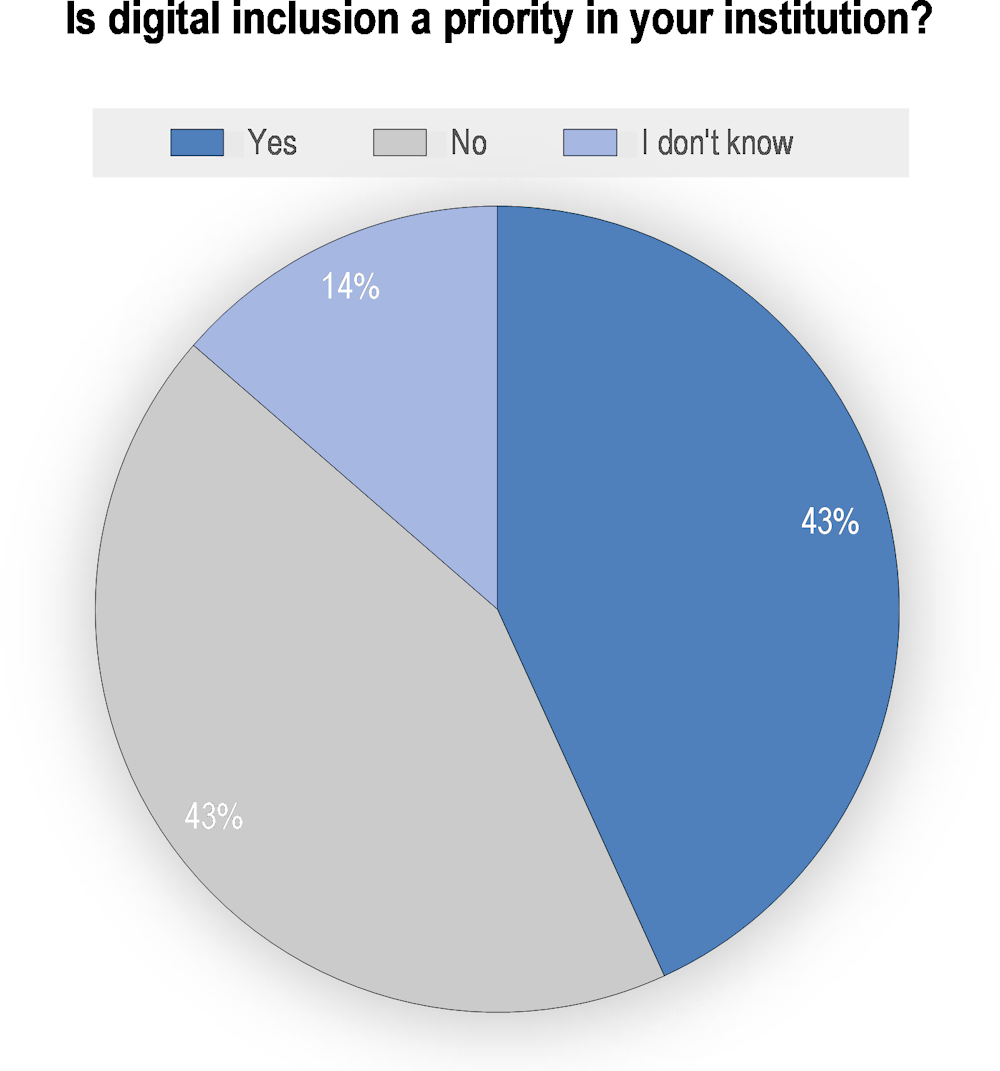
Note: Based on the responses of 45 institutions.
Source: OECD (2020[5]), Digital Government Survey of Slovenia, Public Sector Organisations Version. Question 23 “Is digital inclusion a priority in your institution?”
To become a user-driven public administration and provide user-centric public services, governments should seek digital inclusion and guarantee citizens have enough digital literacy to engage with the public sector in order to voice out their needs and participate in policy and service design processes and to use services online (see Chapter 4). In the case of Slovenia, the country could invest in digital literacy training for its citizens to increase the digital inclusivity of services and empower its citizens to make the most out of public services.
Digital government user skills are the baseline for public servants, as are the 21st century skills for citizens. OECD Government at a Glance 2019 published that half of the OECD countries had put in place IT and digital skills training in their central administrations (OECD, 2019[66]). Indeed, every public servant must understand and master digital government user skills to design and deliver quality public services. The five basic skills, as mentioned above, are recognising the potential of digital for transformation, understanding users and their needs, collaborating openly for iterative delivery, using data and technology in a trustworthy manner and promoting data-driven government. Over the workshop, participants shared that newcomers do not get any training when they first start work. Public institutions in Slovenia seem to have neither standardisation of processes and tools for easier adoption nor a guarantee of security or other standards to help newcomers navigate in public organisations. Ensuring training on digital government user skills for every public servant would establish a common mindset among public servants at an early stage. This is crucial in using digital technologies and data to help rethink and redesign government in ways that respond to the needs of the public.
In a digital government, teams need to be diverse and multidisciplinary to cover perspectives that reflect those of society and bring different types of expertise to the table to best meet citizens’ expectations. More than half of the stakeholders (Figure 3.8) shared that they work with multidisciplinary teams. For small in-house projects, teams usually consist of at least a content specialist, an analyst and a technical expert. For large-scale projects, teams include analysts, designers, engineers, subject matter experts, content specialists, policy makers, procurement professionals, technical experts, developers and infrastructure designers.
Figure 3.8. Use of multidisciplinary teams in the Slovenian government
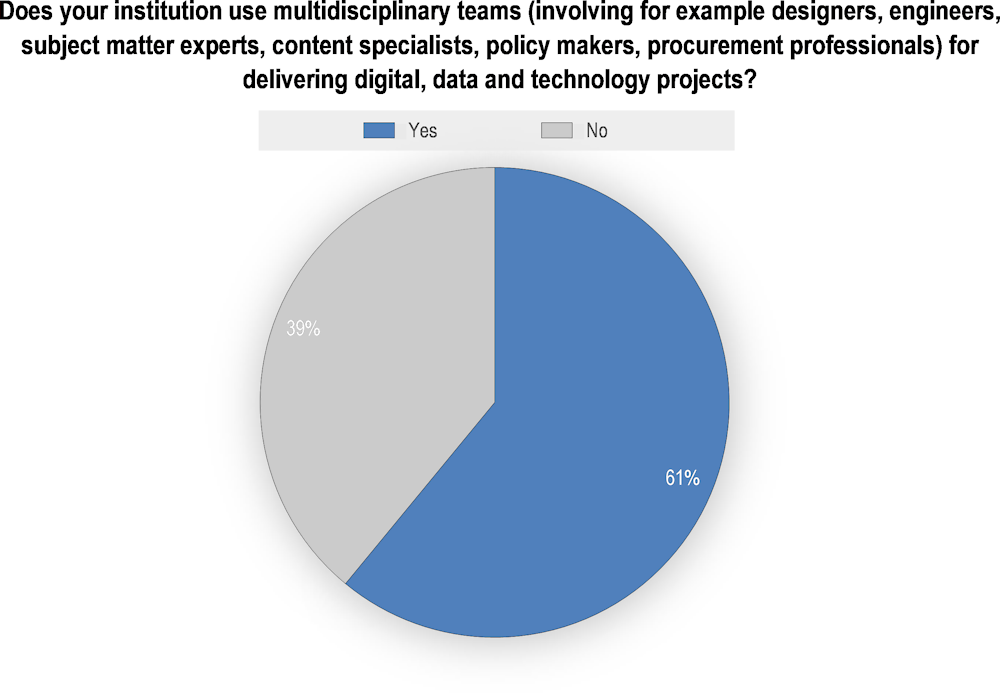
Note: Based on the responses of 45 institutions.
Source: OECD (2020[5]), Digital Government Survey of Slovenia, Public Sector Organisations Version. Question 25 “Does your institution use multidisciplinary teams (involving for example designers, engineers, subject matter experts, content specialists, policy makers, procurement professionals) for delivering digital, data and technology projects?”
As a recognition of this important practice, Spirit Slovenia has formalised the initiative of building multidisciplinary teams within its agency in 2019, where the size and complexity of a project determine their composition of a team. Another example of good practice was the excellent co‑operation between the Ministry of the Interior (MOI), the Faculty of Informatics and a private partner in establishing data registers. In this project, the MOI acted as the subject matter expert, content specialist and policy maker; both the Faculty of Informatics and the private partner acted as designers and engineers for delivering digital, data and technology projects. Mixing professions while balancing digital government socio-emotional skills and digital government professional skills are key elements to building a user-centred digital government.
However, 39% of the survey participants expressed that they did not work in a multidisciplinary team, as it is often complex to have the right composition of skills and constitute a formal team (Figure 3.8). Having the right talent in the right teams can indeed be challenging. In addition to formalising multidisciplinary practices, part of being a digital government is also having a flexible organisational structure to enable the mobility of staff. Allowing staff to change teams and choose the topics they want to work on would be a high source of motivation and job satisfaction for digital talents (further discussed in the next section).
As mentioned in previous chapters and seen in the section above, leaders holding digital government leadership skills are the drivers of digital change. In 2019, almost 70% of OECD countries (25 out of 36) placed a high priority on executive leadership training and coaching (OECD, 2019[66]). This data reveals the crucial role of leaders as catalysts of strategic reforms across the civil service. This means that understanding the five basic digital government user skills, applying them and actively demonstrating the importance of building the right environment to welcome a digital mindset and practices would enable leaders to facilitate and encourage greater digital government maturity.
In Slovenia, the Administration Academy has developed several training courses for top management in the public sector. The Academy has designed a mandatory training programme for top leaders based on a competence model that covers digital aspects and beyond, and recently prepared a new digital competency programme for training all leaders, who will be offered to choose their own training paths. Although some training is organised at leaders’ level, motivation to attend training appears to be low, and public servants in managerial positions do not seem to be able to carve out time for it. If nothing is done, this situation may damage trust towards leaders, as staff may question the reliability and accountability of their leadership in their digital strategy. To improve this, Slovenia could formalise providing the digital government user skills training to all public servants and have leaders join the training along with other staff. As for strengthening their digital government leadership skills, there could be initiatives addressing the benefits of telework and championing new ways of working, so that leaders could view them as an opportunity and not a threat. This would not only strengthen trust within the organisation and make leaders seem more approachable but also increase their motivation and nurture curiosity.
After setting up a favourable work environment with a clear vision for digital transformation, the Slovenian government could then prioritise equipping society with 21st century skills to encourage the use of public services, while making them accessible for all, which echoes the strategies of Slovenia. Along with this, the country could also invest in training staff with the digital government user skills across all levels of the institutions, focusing on the area of user-centricity and emphasising digital delivery skills, design thinking and end-user experience, which are specific to the public sector needs. When building multidisciplinary collaboration across sectors and institutions, it is important to allow job mobility to balance out digital government socio-emotional skills and digital government professional skills within a team, as well as personal preference for a specific project. Leaders with strong digital government knowledge and skills would also help create a digitally mature workplace, which would contribute towards a digitally skilled workforce.
The path to a digital workforce
To align with their overarching digital government, governments can decide to hire people through different types of employment contracts (OECD, 2019[66]). The most common distinction is the permanent public servant status and the contractor status, where pay, job security, performance evaluation and access to training differ. These employment modalities often affect the efficiency in attracting and sustaining talents as well as motivating them to give their best to create high-quality public services. With a clear and well-balanced structure, this can give governments the flexibility to develop and manage their workforce with the proper range of skills. However, if the employment modalities are not used well,services developed by the public sector can be put at risk (OECD, 2019[66]).
Most OECD countries revealed a preference for employing public servants in the central government administrations in 2019 (OECD, 2019[66]). The policy makers acknowledged that the main challenges are to continuously assess skills and competencies needed in the public sector (OECD, 2017[70]) in order to prioritise hiring and maintaining talents in house over outsourcing, particularly in areas with a skills shortage. Therefore, this requires a careful recruitment process and selection along with a recruitment team dedicated to bringing suitable candidates on board.
During the OECD fact-finding mission to Slovenia in October 2019, many public sector institutions shared their concern about having limited funds and a limited number of staff they can hire every year. They cannot recruit new staff unless more senior staff retire. Consequently, in light of the few positions that the public sector of Slovenia can offer every year, institutions could consider having a recruitment team proactively promoting the work, benefits and purpose of the public sector along with clear job descriptions and profiles of talents needed for digital transformation, as this would attract specific candidates fitting the job descriptions. Regarding the recruitment process, it is important to be mindful that, given the current digital needs, traditional recruitment processes no longer work. Instead, it is recommended to evaluate potential candidates by putting them in real situations where they can unleash and apply their digital skills. Also, the best digital talents are rapidly approached and do not stay available on the job market for a long period of time, thus an innovative, smooth and closely tracked recruitment process, like the one in the Pennsylvania states, could be attractive to digital talents.
Box 3.2. Pennsylvania state government recruitment process
Applying for a job with the Pennsylvania state government used to be a daunting process. Jobs posted had vague, bureaucratic titles such as "Administrative Officer 1". Applicants had to take written exams at a testing centre. Some waited months for a civil service commission to respond by mail before they could interview. Many had moved on by then. Recruitment was thus a slow and painful process and would not necessarily get the person with the right skills.
In early 2019, state lawmakers agreed to streamline the 1940s-era system. Now, the agency oversees a centralised website, where job seekers apply for positions that are more clearly defined. Testing and scoring are folded into the online application process, which administrators track closely.
For corrections officer positions, which required candidates to take written examinations until recently, the change had an immediate impact. The number of applicants tripled within the first week of removing that from a test centre environment to applying online for the job.
Source: Ramsey, M. (2020[71]), Hiring Challenges Confront Public-Sector Employers, https://www.shrm.org/hr-today/news/all-things-work/pages/hiring-challenges-confront-public-sector-employers.aspx.
To encourage the best-suited candidates to apply during the recruitment period, Slovenia would benefit from having a merit-based selection process and being seen as a transparent and accountable employer. As the establishment of user-centric public services involves creating a digital workforce that reflects the wider society – representing women, minorities and people with disabilities, particularly in senior management and political leadership positions (OECD, 2019[66]), – having measures to reduce hiring biases and enhance diversity and gender equality of teams in place would be an asset and attract potential talents sharing the same values. Estonia’s example of nudging methods to promote gender equality could be an inspiration.
Box 3.3. Estonia’s nudging methods to increase the share of women in ICT professions
In 2019, Estonia started an 18-month research project led by the Ministry of Social Affairs concentrating on developing and piloting nudge methods to increase the share of women among ICT-sector students and employees. The project is co-funded by the Ministry of Social Affairs and the Estonian Research Council. The following actions are a part of the study:
1. Compiling the current state of play based on existing studies and analysis (including educational choices of girls and women, dropping out of education in the ICT sector, and progress in the job market), mapping the possible reasons for the low number of women in the ICT sector. A qualitative study within main stakeholder groups will be carried out.
2. Presenting proposals for nudging methods with the goal of increasing the number of women in ICT, including in management. These methods need to be piloted for at least nine months.
3. After the pilot phase, carrying out an analysis of the implementation of nudging methods as the basis for a final report and recommendations about future use of nudging methods.
Source: Provided by the Working Party of Senior Digital Government Officials (E-Leaders) Thematic Group on Digital Talent and Skills.
Retention policies are then necessary to keep talents in the workforce. Although the public sector may be able to offer high job security, retention of digital talents remains a challenge as the public sector cannot offer higher financial rewards for the same roles and skills (OECD, 2021[58]). Many public organisations expressed the fear of losing talents to attractive career paths, more generous salary packages and benefits in the private sector. Even if the public sector is not able to provide the same benefits as the private sector, it puts forward other important values that digital talents share. Starting with a more employee-centric approach, governments that demonstrate care for their employees’ well-being and propose professional advancement opportunities usually increase job satisfaction among digital talents. This is an aspect that should be promoted at an early stage, as retention of digital talents starts from recruitment (OECD, 2021[58]). Underlining the meaningful work opportunities that the public sector presents, giving more flexibility for choosing the areas of work that interest them to keep motivation and productivity high, as well as introducing professional and personal growth packages should be seriously considered by the Government of Slovenia.
Developing and maintaining skills are a vital element to keep digital talents learning and ensure the digital transformation be a success, which can be done through formal and informal training. In terms of formal training, although there has been a lot of good work introducing the Administration Academy and training, some specific courses do not seem to be always available. This could put the momentum and motivation of learning at risk. As a result, teams are not always equipped with the necessary skills and are under-resourced; therefore they can only rely on external talents. Although outsourcing is financially more costly than hiring a new talent, due to the structuring policy, this seems to be the only alternative to innovate.
As for informal training, only 27% of public servants noted specific initiatives, such as communities of practice, networking opportunities, mentoring and skills development for data, digital and technology practitioners happening in their institutions (Figure 3.9). These initiatives aim at helping talents to continue developing and maintaining digital skills organically. Building a digital workforce loops back to creating a solid learning culture that stays after formal training and is maintained informally by sharing, testing and learning with and from each other. To reflect such a culture, Slovenia could encourage and empower its digital talents to form communities of practices to share and progress as a group sharing similar interests, regularly hold retrospective meetings where team members could discuss experiences, or organise “show and tell” to share lessons learned. This would thus create a strong in-house production culture, increase ownership and build more independence for external talents, which in the long run would reduce outsourcing activities.
Figure 3.9. Initiatives to maintain and develop digital skills in the Slovenian government
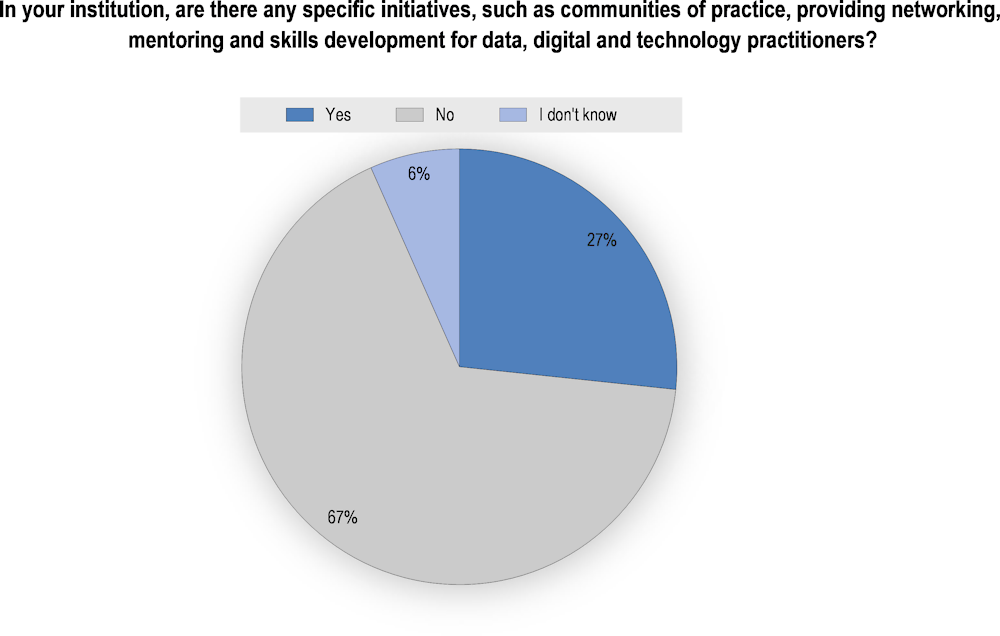
Note: Based on the responses of 45 institutions.
Source: OECD (2020[5]), Digital Government Survey of Slovenia, Public Sector Organisations Version. Question 20 “In your institution, are there any specific initiatives, such as communities of practice, providing networking, mentoring and skills development for data, digital and technology practitioners?”
Another tool to enhance learning and development are mobility programmes; this is particularly crucial to keep talents’ motivation, productivity and job satisfaction high. Despite the fact that only about half of OECD countries have mobility programmes in place, in slightly over 75% of OECD countries, senior managers are given fixed-term appointments (OECD, 2019[66]). This may communicate that these countries value the opportunity to rotate leadership and bring in new skills and experience for this important cohort. Besides this, slightly more than 60% of OECD countries link appointment renewal for senior managers to performance assessment (OECD, 2019[66]).
Based on available data, the organisational structure of central public administrations in Slovenia does not seem to allow mobility of the workforce between policy sectors. This may also explain the fear in public sector organisations of losing talents due to not only more attractive career paths and benefits but also more job flexibility and learning opportunities in the private sector. Such public sector talent management system could thus lead to a decrease in the incentive to professional growth. To improve that, the Government of Slovenia could rethink its organisational structure by funding teams instead of projects, where individuals could focus on their career growth and are encouraged to move from one team to another to not only broaden perspectives, gain skills and experiences but also work on projects that interest them, which could be one of the rewards of good professional performances. For instance, Canada’s Free Agents programme promotes work mobility and invigorate public servants to pursue work that passionate them.
Box 3.4. Canada’s Free Agents programme
Canada’s Free Agents programme was launched in 2016 as a new model for workforce mobilisation. It offers public servants the freedom to select work that matches their skills and interests and allows them to make a contribution that they find meaningful. It also supports managers looking to acquire top talent rapidly and easily with emerging and core skills to support their short-term project needs. Free Agents are screened for attributes that are beneficial for solving problems and skills that are in demand.
Source: Provided by the Working Party of Senior Digital Government Officials (E-Leaders) Thematic Group on Digital Talent and Skills.
To ensure the assignment of talents is suitable, it is necessary that public servants meet with their managers regularly to set achievable goals and secure a feedback loop culture to verify that they are well supported to execute their tasks successfully. Slovenia incorporates this activity into law with the Public Employees Act; the act requires superiors to monitor the work, professional qualifications and careers of public employees and to hold at least one annual interview with each employee, discussing the potential need for training to improve their work performance, professional knowledge and career development (OECD, 2021[58]). However, in addition to managing performance, there appears to be a need for more mentoring and tutoring opportunities to encourage the transfer of skills, experience and knowledge between staff. This would not only reinforce the learning culture of the organisation and strengthen the sense of belonging but also generate in-house training and cultivate loyalty, which would create greater workforce sustainability.
The practices that build a digital workforce are highly supported by a digital enabling environment, which is why reforming the environment to transform digitally is an essential step. Nevertheless, there seems to be some resistance to change. Some stakeholders observed the generational divide between the younger and the more senior workforce as being a current challenge to moving forward with the digital transformation. Although teleworking has demonstrated the value of a digital government during COVID-19, change has not been adopted by all.
However, some measures could be taken to move towards the path of a digital workforce. Given the job market options, it is necessary for governments to position themselves as attractive employers, giving candidates the chance to develop their careers while serving society. Employers may consider developing accurate job profiles and descriptions, as this gives them the chance to paint a clearer picture of the roles available. The Government of Slovenia may also consider adjusting its recruitment efforts and use creative ways to reflect the organisational culture and values, such gamification of skills assessments, as well as promoting itself as a merit-based employer. In today’s environment, digital maturity and agility of a workplace are important selection criteria for strong candidates; thus re-thinking their reward systems, training packages, career paths, job mobility and mentorship plans could equally contribute to making the workplace more attractive.